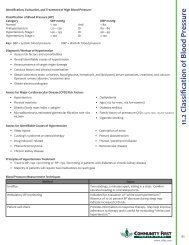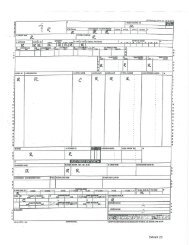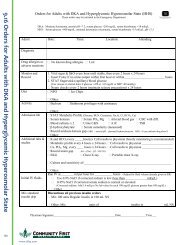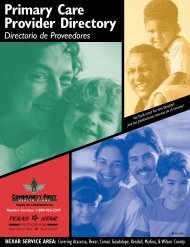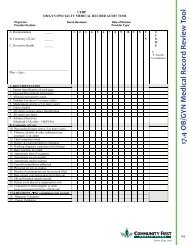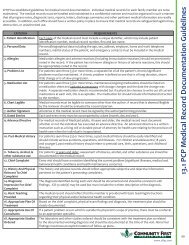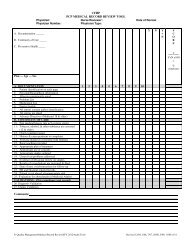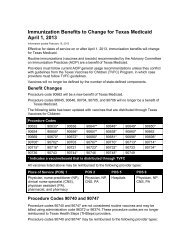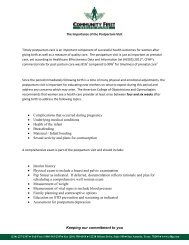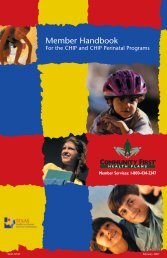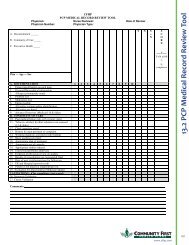Full Clinical Guidelines - Community First Health Plans.
Full Clinical Guidelines - Community First Health Plans.
Full Clinical Guidelines - Community First Health Plans.
Create successful ePaper yourself
Turn your PDF publications into a flip-book with our unique Google optimized e-Paper software.
FIGURE 2: Recommended immunization schedule for persons aged 7 through 18 years—United States, 2012 (for those who fall behind or start late, see the<br />
schedule below and the catch-up schedule [Figure 3])<br />
Vaccine ▼ Age ► 7–10 years 11–12 years 13–18 years<br />
Tetanus, diphtheria, pertussis 1<br />
Human papillomavirus 2<br />
Meningococcal 3<br />
Influenza 4<br />
Pneumococcal 5<br />
Hepatitis A 6<br />
Hepatitis B 7<br />
Inactivated poliovirus 8<br />
Measles, mumps, rubella 9<br />
Varicella 10<br />
This schedule includes recommendations in effect as of December 23, 2011. Any dose not administered at the recommended age should be administered at a subsequent<br />
visit, when indicated and feasible. The use of a combination vaccine generally is preferred over separate injections of its equivalent component vaccines. Vaccination providers<br />
should consult the relevant Advisory Committee on Immunization Practices (ACIP) statement for detailed recommendations, available online at http://www.cdc.gov/vaccines/<br />
pubs/acip-list.htm. <strong>Clinical</strong>ly significant adverse events that follow vaccination should be reported to the Vaccine Adverse Event Reporting System (VAERS) online (http://www.<br />
vaers.hhs.gov) or by telephone (800-822-7967).<br />
1. Tetanus and diphtheria toxoids and acellular pertussis (Tdap) vaccine.<br />
(Minimum age: 10 years for Boostrix and 11 years for Adacel)<br />
• Persons aged 11 through 18 years who have not received Tdap vaccine<br />
should receive a dose followed by tetanus and diphtheria toxoids (Td)<br />
booster doses every 10 years thereafter.<br />
• Tdap vaccine should be substituted for a single dose of Td in the catchup<br />
series for children aged 7 through 10 years. Refer to the catch-up<br />
schedule if additional doses of tetanus and diphtheria toxoid–containing<br />
vaccine are needed.<br />
• Tdap vaccine can be administered regardless of the interval since the last<br />
tetanus and diphtheria toxoid–containing vaccine.<br />
2. Human papillomavirus (HPV) vaccines (HPV4 [Gardasil] and HPV2<br />
[Cervarix]). (Minimum age: 9 years)<br />
• Either HPV4 or HPV2 is recommended in a 3-dose series for females<br />
aged 11 or 12 years. HPV4 is recommended in a 3-dose series for males<br />
aged 11 or 12 years.<br />
• The vaccine series can be started beginning at age 9 years.<br />
• Administer the second dose 1 to 2 months after the first dose and the<br />
third dose 6 months after the first dose (at least 24 weeks after the first<br />
dose).<br />
• See MMWR 2010;59:626–32, available at http://www.cdc.gov/mmwr/pdf/<br />
wk/mm5920.pdf.<br />
3. Meningococcal conjugate vaccines, quadrivalent (MCV4).<br />
• Administer MCV4 at age 11 through 12 years with a booster dose at age<br />
16 years.<br />
• Administer MCV4 at age 13 through 18 years if patient is not previously<br />
vaccinated.<br />
• If the first dose is administered at age 13 through 15 years, a booster<br />
dose should be administered at age 16 through 18 years with a minimum<br />
interval of at least 8 weeks after the preceding dose.<br />
• If the first dose is administered at age 16 years or older, a booster dose is<br />
not needed.<br />
• Administer 2 primary doses at least 8 weeks apart to previously<br />
unvaccinated persons with persistent complement component deficiency<br />
or anatomic/functional asplenia, and 1 dose every 5 years thereafter.<br />
• Adolescents aged 11 through 18 years with human immunodeficiency<br />
virus (HIV) infection should receive a 2-dose primary series of MCV4, at<br />
least 8 weeks apart.<br />
• See MMWR 2011;60:72–76, available at http://www.cdc.gov/mmwr/<br />
pdf/wk/mm6003.pdf, and Vaccines for Children Program resolution No.<br />
6/11-1, available at http://www.cdc.gov/vaccines/programs/vfc/downloads/<br />
resolutions/06-11mening-mcv.pdf, for further guidelines.<br />
4. Influenza vaccines (trivalent inactivated influenza vaccine [TIV] and<br />
live, attenuated influenza vaccine [LAIV]).<br />
• For most healthy, nonpregnant persons, either LAIV or TIV may be used,<br />
except LAIV should not be used for some persons, including those with<br />
asthma or any other underlying medical conditions that predispose them<br />
to influenza complications. For all other contraindications to use of LAIV,<br />
see MMWR 2010;59(No.RR-8), available at http://www.cdc.gov/mmwr/<br />
pdf/rr/rr5908.pdf.<br />
• Administer 1 dose to persons aged 9 years and older.<br />
1 dose (if indicated) 1 dose<br />
1 dose (if indicated)<br />
see footnote 2<br />
3 doses<br />
Complete 3-dose series<br />
See footnote 3<br />
Dose 1<br />
Booster at 16 years old<br />
Influenza (yearly)<br />
See footnote 5<br />
Complete 2-dose series<br />
Complete 3-dose series<br />
Complete 3-dose series<br />
Complete 2-Dose 2-dose series Series<br />
Complete 2-dose series<br />
Range of<br />
recommended<br />
ages for all<br />
children<br />
Range of<br />
recommended<br />
ages for<br />
catch-up<br />
immunization<br />
Range of<br />
recommended<br />
ages for certain<br />
high-risk<br />
groups<br />
• For children aged 6 months through 8 years:<br />
— For the 2011–12 season, administer 2 doses (separated by at least<br />
4 weeks) to those who did not receive at least 1 dose of the 2010–<br />
11 vaccine. Those who received at least 1 dose of the 2010–11<br />
vaccine require 1 dose for the 2011–12 season.<br />
— For the 2012–13 season, follow dosing guidelines in the 2012 ACIP<br />
influenza vaccine recommendations.<br />
5. Pneumococcal vaccines (pneumococcal conjugate vaccine [PCV] and<br />
pneumococcal polysaccharide vaccine [PPSV]).<br />
• A single dose of PCV may be administered to children aged 6 through<br />
18 years who have anatomic/functional asplenia, HIV infection or other<br />
immunocompromising condition, cochlear implant, or cerebral spinal fluid<br />
leak. See MMWR 2010:59(No. RR-11), available at http://www.cdc.gov/<br />
mmwr/pdf/rr/rr5911.pdf.<br />
• Administer PPSV at least 8 weeks after the last dose of PCV to children<br />
aged 2 years or older with certain underlying medical conditions,<br />
including a cochlear implant. A single revaccination should be<br />
administered after 5 years to children with anatomic/functional asplenia or<br />
an immunocompromising condition.<br />
6. Hepatitis A (HepA) vaccine.<br />
• HepA vaccine is recommended for children older than 23 months who<br />
live in areas where vaccination programs target older children, who are at<br />
increased risk for infection, or for whom immunity against hepatitis A virus<br />
infection is desired. See MMWR 2006;55(No. RR-7), available at http://<br />
www.cdc.gov/mmwr/pdf/rr/rr5507.pdf.<br />
• Administer 2 doses at least 6 months apart to unvaccinated persons.<br />
7. Hepatitis B (HepB) vaccine.<br />
• Administer the 3-dose series to those not previously vaccinated.<br />
• For those with incomplete vaccination, follow the catch-up<br />
recommendations (Figure 3).<br />
• A 2-dose series (doses separated by at least 4 months) of adult<br />
formulation Recombivax HB is licensed for use in children aged 11<br />
through 15 years.<br />
8. Inactivated poliovirus vaccine (IPV).<br />
• The final dose in the series should be administered at least 6 months<br />
after the previous dose.<br />
• If both OPV and IPV were administered as part of a series, a total of 4<br />
doses should be administered, regardless of the child’s current age.<br />
• IPV is not routinely recommended for U.S. residents aged18 years or<br />
older.<br />
9. Measles, mumps, and rubella (MMR) vaccine.<br />
• The minimum interval between the 2 doses of MMR vaccine is 4 weeks.<br />
10. Varicella (VAR) vaccine.<br />
• For persons without evidence of immunity (see MMWR 2007;56[No. RR-<br />
4], available at http://www.cdc.gov/mmwr/pdf/rr/rr5604.pdf), administer 2<br />
doses if not previously vaccinated or the second dose if only 1 dose has<br />
been administered.<br />
• For persons aged 7 through 12 years, the recommended minimum interval<br />
between doses is 3 months. However, if the second dose was administered<br />
at least 4 weeks after the first dose, it can be accepted as valid.<br />
• For persons aged 13 years and older, the minimum interval between<br />
doses is 4 weeks.<br />
16.2.2 Immunization Schedule 7-18 years<br />
This schedule is approved by the Advisory Committee on Immunization Practices (http://www.cdc.gov/vaccines/recs/acip),<br />
the American Academy of Pediatrics (http://www.aap.org), and the American Academy of Family Physicians (http://www.aafp.org).<br />
Department of <strong>Health</strong> and Human Services • Centers for Disease Control and Prevention<br />
H EALTH PLANS<br />
www.cfhp.com<br />
141



